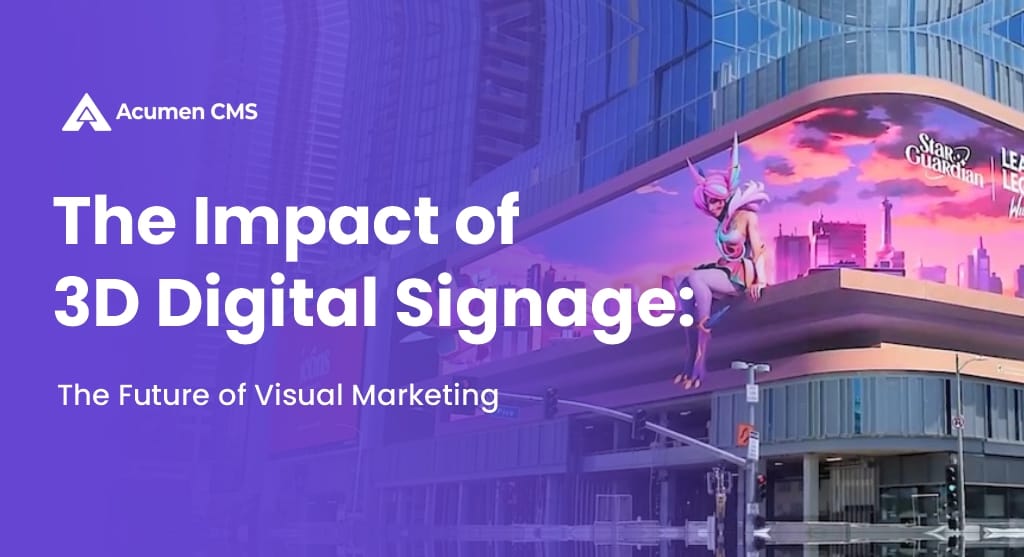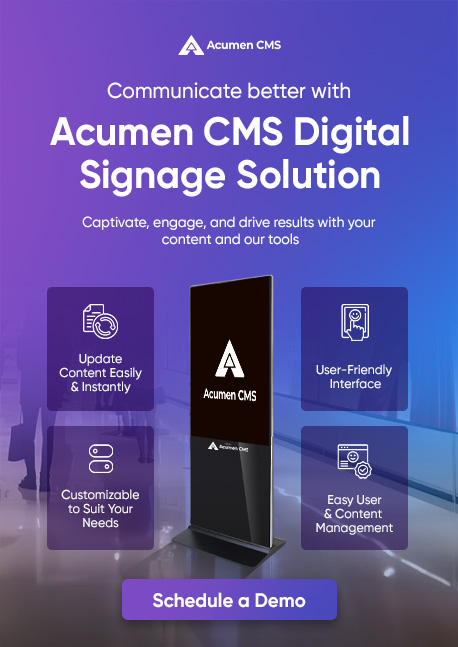Imagine captivating your audience with real visuals that seem to jump out of the screen—welcome to the world of 3D digital signage!
This cutting-edge technology is changing how businesses communicate with their customers.
From retail stores to grand events, 3D digital signage is becoming a powerful marketing tool.
In this blog, we’ll explore-
- What 3D digital signage is,
- How it works, and
- Its application in different industries
By the end, you’ll understand why this innovative solution is worth considering for your marketing strategy.
So, let’s start!
What is 3D Digital Signage? & How does it Work?
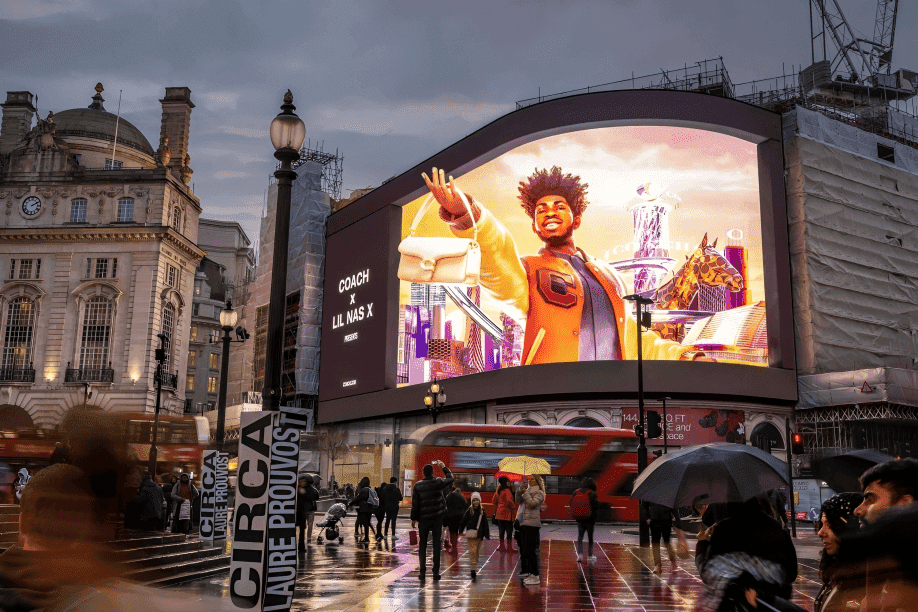
Before understanding 3D digital display it is important to understand what is Digital signage first.
Digital signage is a system that uses electronic screens to display information, advertisements, or any other content. You may have seen these displays in malls, airports, and restaurants.
3D digital signage is a display technology that creates visuals with depth and realism, making them appear highly realistic. Unlike traditional flat displays, 3D signage technology engages audiences by simulating three-dimensional visuals that are hard to ignore.
How 3D Digital Signage is Different from Traditional Signage? Here are 3 key features that set 3D Digital Signage apart from others.
1. Autostereoscopic Display
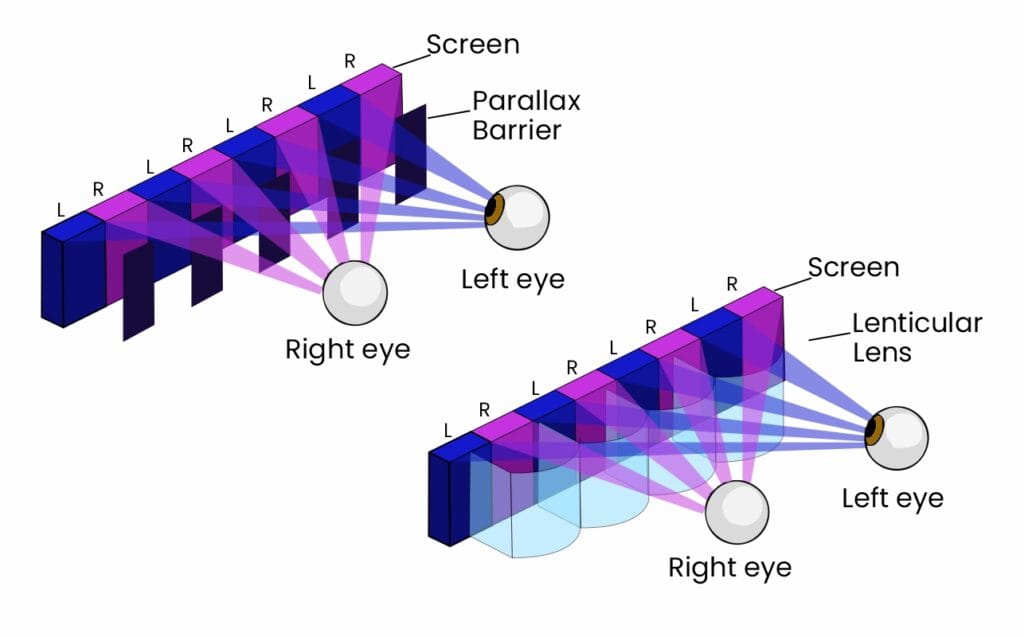
Autostereoscopy is nothing but a new method of showing stereoscopic images without using special headgear.
It does not need any wearable accessories, which ensures a seamless and engaging experience that is perfect for capturing the attention of audiences in various settings such as retail, events, and exhibitions.
2. Holographic Projection

Holographic Projection is the technology of developing 3D images that appear to float in the air and can be viewed from any angle. By projecting images that seem to float in the air, holography provides a futuristic way to showcase products, services, or concepts.
3. AI Integration

It simplifies the whole process and improves the impact of 3D Digital Signage. AI assists us in everything from 3D image or video ideation/ generation to publishing and calculating its overall impact.
Nowadays, there are various AI tools in the market that automate a significant amount of work of 3D creators and publishers.
For example, you can use freepik to generate high-quality images in just a couple of minutes.
4. Immersive Experience
By combining these 3 technologies, 3D digital signage creates an immersive experience that holds the viewer’s attention longer than traditional displays.
This 3D signage technology naturally grabs the attention of potential customers and turns them into actual customers, boosting the revenue of companies.
Benefits of 3D Digital Signage
Have you ever wondered why global brands like Nike and Hyundai are investing heavily in 3D Digital Signage technology?
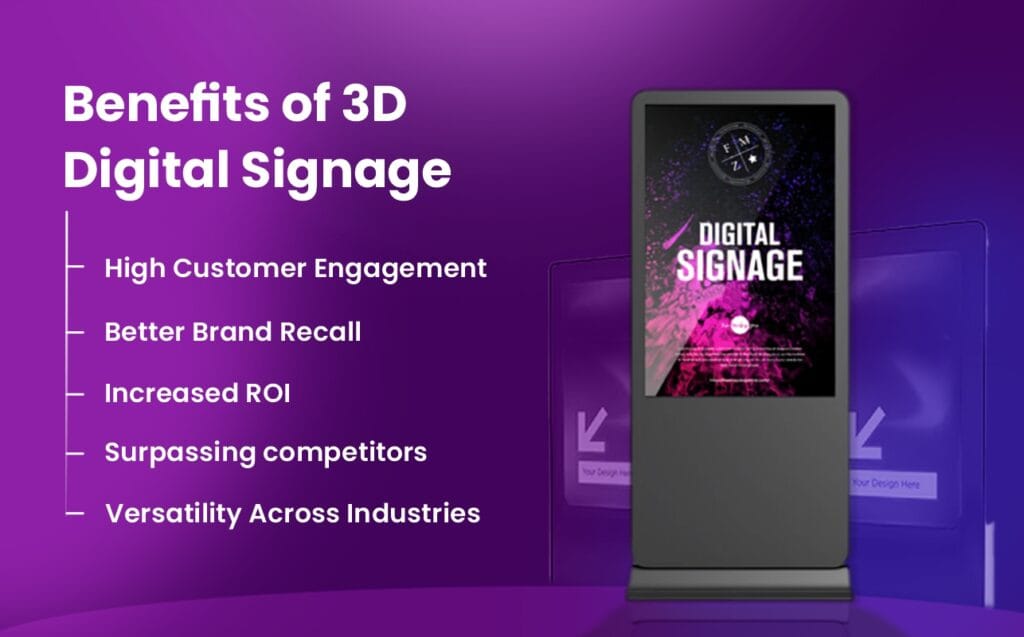
There are various reasons and benefits of 3D displays, and we have listed the top 5 of them below.
- High Customer Engagement
3D digital signage catches a significant amount of attention that no other type of display device does.
Where conventional signage goes about life looking rather dull, the 3D visual appeals with movement and vibrancy at a glance, immediately catching the eye.
Such eye-catching nature in crowded environments makes this type of display highly effective at malls, retail stores, or trade shows.
Immersiveness makes the attraction to stay with your brand much longer and may result in potential customers’ attention towards your product.
More than that, lifelike effects evoke wonder and curiosity, thus forcing viewers to be involved with the content.
Be it a product presentation or a brand message, 3D digital signage turns passive viewers into active participants, leading to stronger customer connections & engagement.
- Better Brand Recall
In a competitive market, it is very important to stand out, and 3D digital signage does that.
Its displays are visually appealing and memorable to the viewer’s mind.
The depth and motion of 3D visuals have been scientifically proven to improve memory retention. A customer is more likely to remember a brand using innovative and impactful marketing tools.
This improved recall leads to increased word-of-mouth marketing because satisfied viewers often share their experiences with others.
For companies, this results in increased visibility and brand awareness. Leaving an impression, 3D digital signage will keep your brand at the top of your customers’ minds.
- Increased ROI (Return On Investment)
The investment in 3D digital signage is likely to give businesses huge returns.
The more attractive 3D visuals attract more foot traffic and encourage deeper customer interaction, thus increasing the conversion rate.
The more a customer interacts with your brand, the more likely he or she is to make a purchase or explore your services.
Further, 3D signage minimizes the use of several traditional displays as a single 3D display can create more impact.
In the long run, this saves businesses money on marketing while yielding better results.
- Surpassing competitors
In today’s competitive market, standing out is critical, and 3D digital signage provides businesses with that distinct edge.
Unlike traditional 2D displays that customers see everywhere, 3D visuals easily capture attention with their unique depth and realism. This technological advantage sets your brand apart, making your marketing efforts much more memorable.
3D signage technology creates a “wow” effect in retail, events, or advertising, so no one who uses the older methods can equal that.
Innovation and engagingness of customer experience are key advantages for businesses against their rivals to dominate the market.
It doesn’t only bring customers to your brand but positions you as the forward-thinking leader in the market, thereby making the competition silenceable with an unmatchable visual appeal.
- Versatility Across Industries
One of the main strengths of 3D digital signage is that it is highly versatile.
It does not apply solely to retail or advertising; rather, it finds a place in sectors such as education, healthcare, and entertainment.
In retail, it is applied to products that can be demonstrated in an interactive manner; in healthcare, complex medical ideas are explained using 3D visualizations; in the entertainment industry, it is used for adding excitement to movie promotions, concerts, and gaming events.
Even educational institutions make use of it to make challenging topics easier to understand for the students.
Therefore, this wide scope of applications gives 3D digital signage the flexibility to cater to the individual needs of varied industries. This makes 3D digital billboards relevant and valuable to various sectors.
Applications of 3D Digital Signage
1. Application of 3D Digital Signage in Retail Sector –
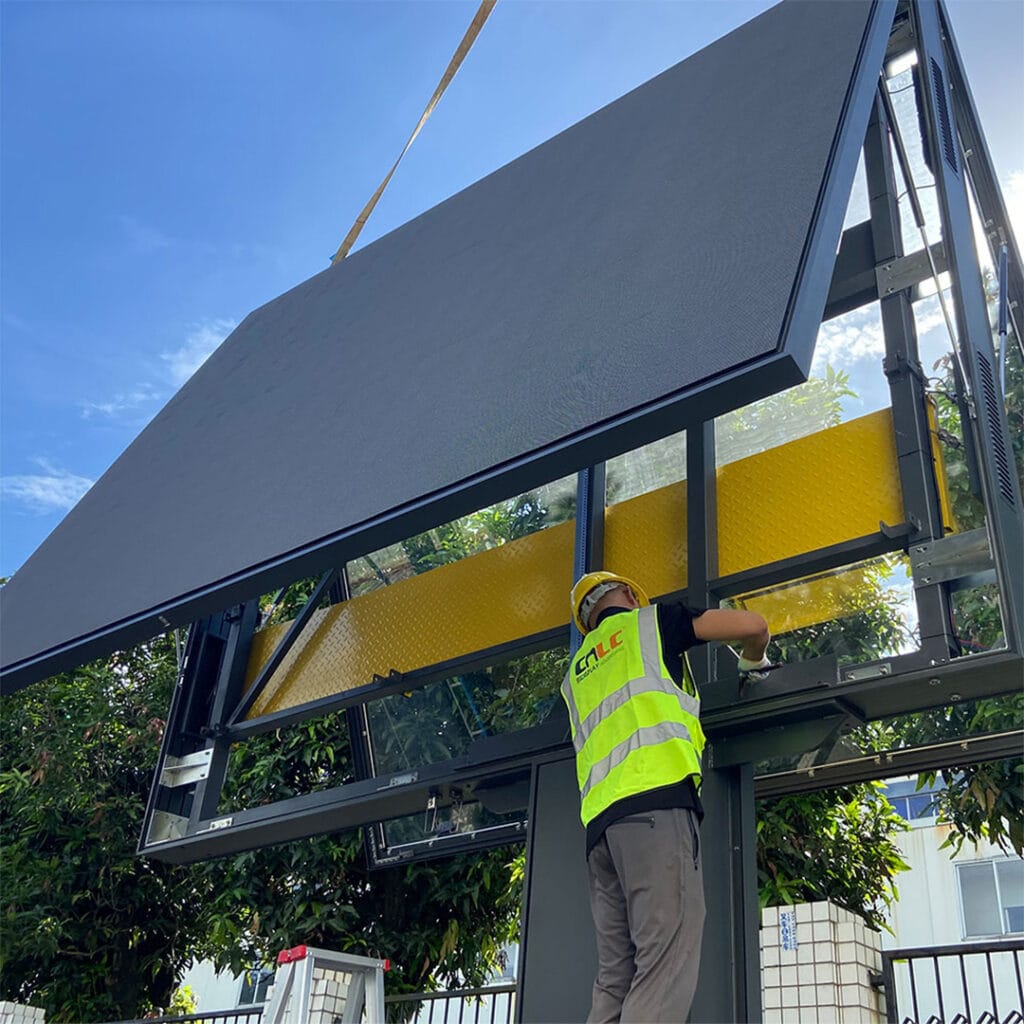
3D digital signage has completely transformed the retail space as products are shown in lifelike, interactive ways. Imagine a shoe that seems to float in mid-air or clothing shown interactively on a digital model.
Customers are attracted by such displays, which makes them want to touch and buy more.
The offering of an immersive shopping experience increases customer engagement and increases foot traffic.
Furthermore, 3D signage helps businesses to emphasize promotions and new arrivals, making it a strong sales and customer loyalty booster.
Must Read
How Digital Screens in Retail Improve Store Engagement and Increase Sales
2. Events & Exhibitions
Innovative 3D displays are a great way to attract more visitors and to make sure your booth gets as much attention as possible at events and exhibitions.
It has an engaging display and lots of visuals that present an immersive environment for its guests. Whether presenting products in 3D or powerful branding messages, this technology makes a lasting impression.
It also boosts interaction with the audience and gives promotion to your brand’s cutting-edge image. It has the versatility to help make memories for event organizers that have higher engagement and is competitive.
3. Use of 3D Display Technology in the Entertainment Sector
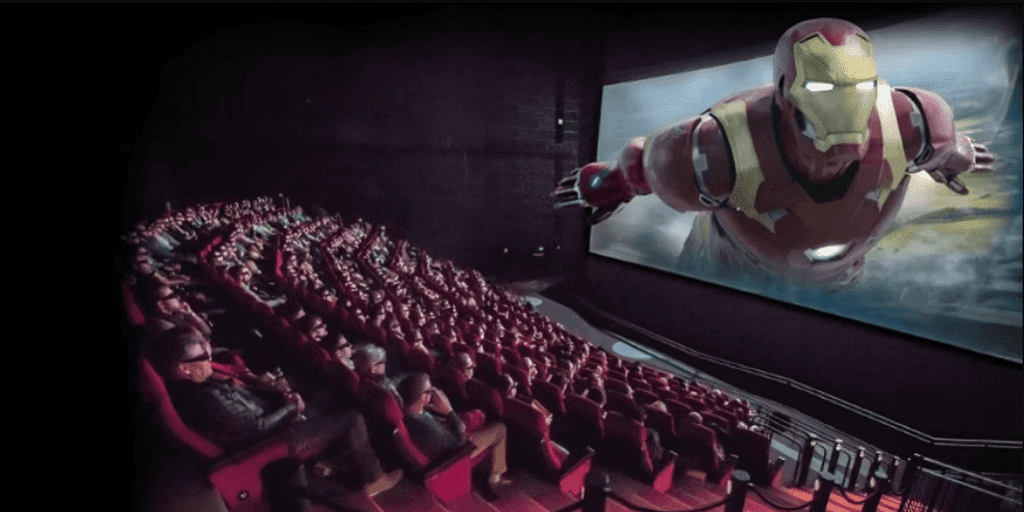
3D digital signage adds excitement to the entertainment industry, elevating promotions and events.
Movie theaters use 3D displays to present trailers and movies in lifelike detail, while concerts and gaming events captivate audiences with immersive visuals.
A 3D digital billboard shows movie characters stepping off the screen, making the experience unforgettable.
These engaging visuals draw in audiences, spark curiosity, and boost ticket sales.
By enhancing storytelling, 3D signage takes entertainment experiences to the next level and makes campaigns more impactful.
4. 3D Digital Displays in Education
3D digital signage makes education more engaging by bringing complex concepts to life. The students go on to visually see scientific models, historical landmarks, or abstract ideas in lifelike 3D visuals, thereby getting a better understanding.
Interactive lessons are taught using 3D displays in schools, making students participate and be curious. Teachers can explain the topics dynamically, turning passive learning into active discovery.
Unlike traditional classrooms, modern classrooms powered by 3D signage improve a school’s overall performance.
5. Hospitals
Three-dimensional digital signage simplifies difficult medical explanations to enhance healthcare. Hospitals utilize interactive 3D models for patients and internal teams to understand diagnoses as well as treatments.
Medical professionals rely on 3D visuals for effective training – from realistic anatomy to procedures. Clinics display medical equipment or treatments in an interesting way that could help build patient trust and confidence.
Improving communication and understanding, 3D signage not only enhances patient education but also strengthens the connection between healthcare providers and patients.
Real-Life Impact: Nike Japan’s 3D Ad Success Story
One of the most impressive examples that demonstrate how 3D digital signage can be used practically is Nike Japan’s 3D outdoor ad.
It was a beautiful display that, set in Shinjuku, Tokyo, really won global attention for its creativity and innovation.
It showed a pair of Nike sneakers floating, twisting, and moving sharply within the digital screen.
With the use of advanced 3D signage technology, the ad produced an immersive experience for passersby.
The movements of the sneakers, the realistic kind, and dynamic visual effects both attracted attention and solidified leading-edge, trendy brands.
The campaign was highly successful in generating foot traffic in stores, showing that 3D digital signage has much to offer.
How Much Does a 3D Billboard Cost?
Now you might be wondering Costs of Digital Signage?
So, now let’s talk about it.
The cost of a 3D digital billboard depends on several factors:
- Size: Larger displays naturally cost more.
- Resolution: Higher resolutions provide better visuals but come at a premium.
- Technology Used: Advanced features like AI or holography increase costs.
Typically, a 3D digital billboard can cost anywhere between ₹5 lakhs and ₹20 lakhs. While the initial investment is high, the returns often justify the expense.
Challenges of Implementing 3D Digital Signage
You may have noticed that 3D billboards are very rare in India. We don’t see them everywhere like other 2D digital billboards.
This is because there are some major challenges in installing 3D digital signage. We have listed some of them below.
- High Initial Cost
As we have discussed above, it is clear that the initial cost of 3D billboard installation is around ₹5 lakhs, which is very expensive for many businesses.
- Content Creation
Creating engaging 3D visuals requires specialized skills and tools. Many businesses find this to be a challenge.
- Technical Maintenance
Ensuring that the displays work seamlessly requires regular maintenance and updates, adding to operational costs.
- Location-Specific Limitations
This is one of the major reasons behind the rarity of 3D digital billboards in India. 3D digital signage cannot be installed anywhere you want due to location-specific constraints.
Outdoor environments require sturdy and weather-resistant displays, which can significantly increase costs.
Additionally, certain areas may lack the necessary infrastructure, such as stable power sources to support these advanced displays.
How to Get Started with 3D Digital Signage
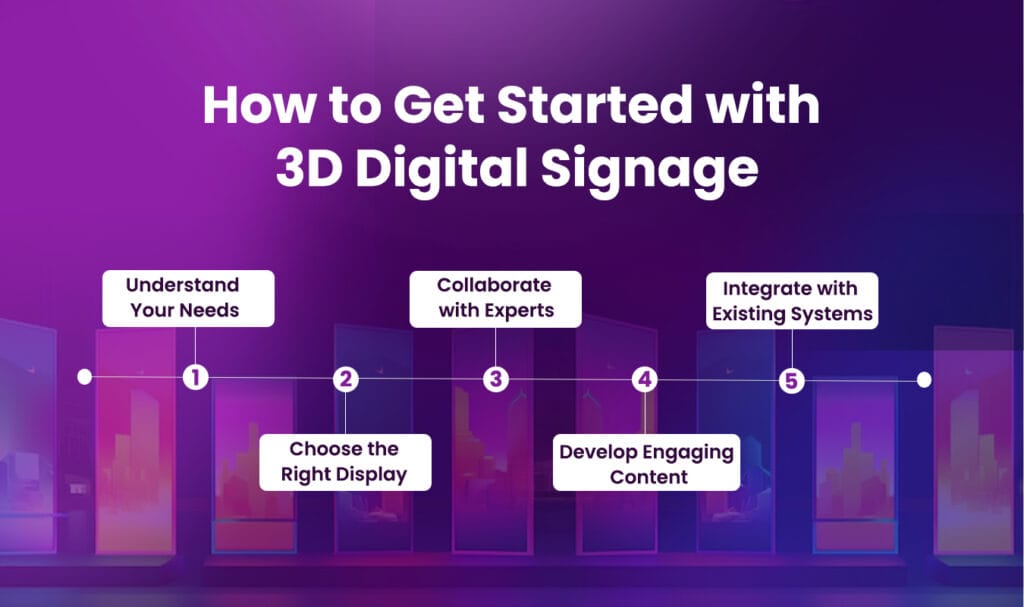
1. Choose the Right Display Technology
Selecting the right 3D signage solution is key to maximizing its effectiveness. Start with your business goals, target audience, and budget.
Options include holographic displays or autostereoscopic screens.
For example, retail stores might find dynamic holograms suitable for their requirements, while educational institutions may prefer interactive autostereoscopic screens.
The size, resolution, and durability of the display should also match your environment.
A well-chosen technology will guarantee that your 3D signage is delivered impactful and visually attractive, in terms of what suits your specific requirements.
2. Collaborate with Experts
Working with professionals guarantees your 3D digital signage setup is perfect.
Experienced vendors will suggest the best technology to use, customize your content, and manage installation effectively.
They guarantee ongoing support with the operational and maintenance processes, ensuring that everything runs smoothly.
Having a professional help you reduces technical problems and ensures viewing quality. Whether in retail, events, or education, your vision comes into life because they take care of the technical work while you are busy engaging your audience.
3. Focus on Engaging Content
Content is the heart of successful 3D digital signage. Develop images that are lively, interactive, and supportive of your brand message.
Promote products or services, or even run special promotions, in ways that catch your audience’s attention.
Apply storytelling techniques to elicit emotional responses and help them remember your content. Don’t clutter your images; the simpler, the stronger.
Content must be changed regularly to maintain freshness and relevance. Good content maximizes the potential of your 3D signage, thus making it pop and drive results.
4. Integrate with Existing Systems
Integrating your 3D signage with existing marketing tools makes it more functional and accessible.
Make sure it is compatible with content management systems, analytics software, and digital platforms for easy operation. It can be updated in real-time, personalized, and targeted towards a specific audience.
For instance, integrating 3D signage with AI-driven tools will allow the content to be personalized according to specific demographics.
A connected system will streamline your marketing efforts, and ensure consistent branding, and efficient content management. This holistic approach guarantees that your 3D signage delivers maximum impact.
Future of 3D Digital Signage
As technology evolves, 3D digital signage becomes more accessible and versatile.
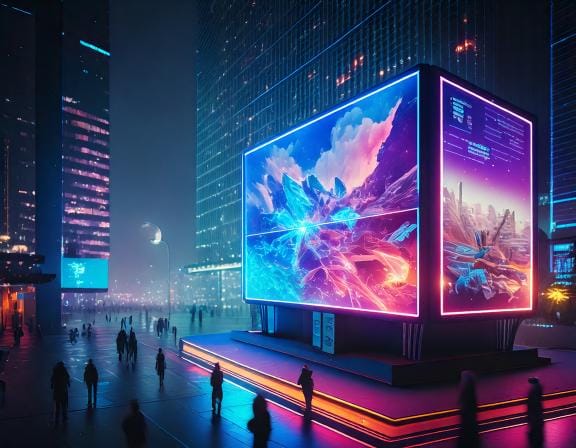
Trends such as AI-driven personalization enable content to adapt to individual viewer preferences, thus creating more engaging and personalized experiences.
The integration of augmented reality into 3D displays offers even more immersive and interactive visuals.
Furthermore, the cost continues to decline due to constant innovations, thus making it possible for businesses of all sizes to adopt this technology.
The innovations are leading to further growth as more companies can now use 3D digital signage as a transformational display facility to wow audiences.
Transform Your Visual Marketing with Acumen CMS Today
3D digital signage isn’t just a display solution; it’s a way to captivate, engage, and convert your audience.
Whether you’re in retail, hospitality, or entertainment, this technology can elevate your marketing game.
Ready to explore the possibilities?
Contact Acumen CMS for a free consultation and discover how 3D digital signage can bring your vision to life.
We are Acumen CMS, already working with hundreds of business owners like e you, and have installed more than 30,000 digital signage across India.
If you also want to cope with this new and modern marketing world to boost your revenue, then Book Your Demo Right now.
Frequently Asked Questions (FAQs)
3D digital signage uses advanced technology to create lifelike, three-dimensional visuals, offering immersive and engaging displays without requiring viewers to wear special glasses.
A 3D billboard typically costs ₹5 lakhs to ₹20 lakhs, depending on factors like size, resolution, and technology features.
Yes, India has 3D billboards in cities like Mumbai and Delhi, showcasing stunning visuals that captivate audiences and enhance marketing campaigns.

